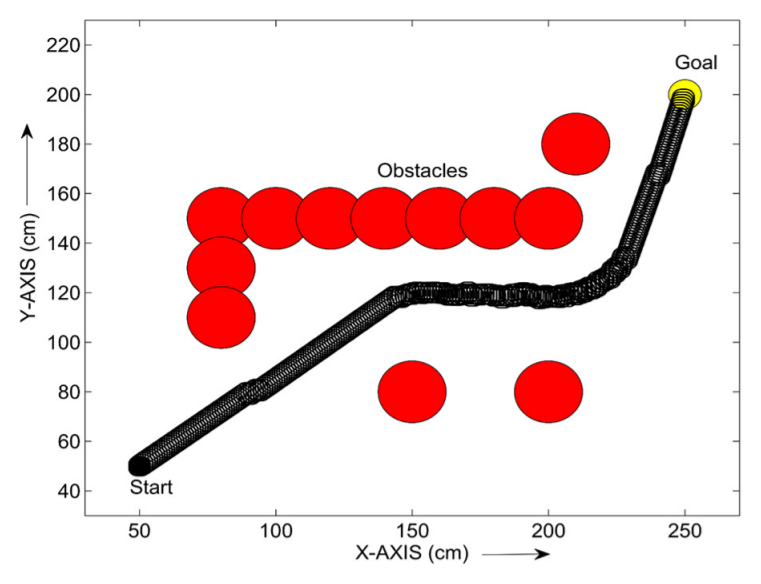Robotics is a discipline of engineering and computer science that deals with robots’ design, manufacture, maintenance, and utilization. Robotics strives to create devices that can support and benefit people. Mechanical engineering, mechatronics, information engineering, electronics, biotechnology, computer programming, software development, and mathematics are included in robotics. In designing a robot, it is necessary to highlight the stage of testing and simulations, which, combined into separate courses, can identify possible drawbacks and errors. What concerns the elaboration of an obstacle course in a “real-world” simulation, it is essential to ensure the presence of several procedure testing steps that will determine the functionality of a robot.
A robot is considered a machine capable of automatically performing a complicated set of activities, particularly one that a computer can program. Advanced cyber-physical technologies, including robotics systems, are often associated with the physical and software components that are supposed to alter over time (Jamshidi et al., 2019). A remote control system can direct a robot, or the control can be included inside the machine itself. Although some robots are meant to resemble humans, most are task-oriented technologies focusing on basic utility rather than expressive aesthetics. Humanoids, industrial machines, medical operational robots, patient aid robotic systems, cooperatively programmed robots, and minuscule nanorobots are examples of autonomous and semi-autonomous robots. A robot may obtain a sense of consciousness or think of its own by replicating a realistic look or automating motions, and autonomous devices are likely to transmit in the future.
Considering the process of constructing a robot, it is important to highlight several specific building stages that can be universal. Establishing a purpose for the robot is the first phase, which allows determining its specific capabilities, which, as a result, will help the creators set the necessary tasks. Secondly, select whether the robot will operate on a manufacturing or intelligent operating system, depending on whether constructors are developing an industrial or conceptual computer. Thirdly, designing the machine’s central command module, which will be in charge of decision-making, and constructing a shell will provide physical characteristics and functionality.
The purpose of the course is defined by the need to ensure the robot can navigate in space, detect barriers and effectively abolish them. In order to elaborate an obstacle course that can test the autonomy of simple robots, it is possible to select a “real-world” simulation as a course general design approach. What concerns a “real-world” simulation, this testing concept is based on the assessment of how efficiently a robot is able to avoid obstacles and solve issues in practical and real circumstances, as in Figure 1 (Pandey et al., 2019). Moreover, in this simulation, a robot’s performance is scored and analyzed in a scoring system, which collects and sorts data. Firstly, to create a specific course, it is obligatory to identify the design concept and the key features and components of the robot that has to be tested.

Referring to the technical characteristics and components, the robot will include chassis, wheels, motors, motherboards, a proportional integrative derivative controller, and a microprocessor that will allow the robot to execute a program. Since the course design is dedicated to the ability of a robot to avoid real obstacles in a condition of a simulation, it is important to emphasize the presence of sensor component options. The robot should possess a metal detector that can identify objects on the ground, ultrasonic sensors that determine proximity to objects, and a compass that uses the Earth’s magnetic field to select directions. In addition, it is essential to apply LED flasher technology since it emits flashing lights at variable frequencies.
What concerns the map of the proposed course, it can be stated that it should be compiled of conditions and challenges for the moving process of a robot. Furthermore, it should include a function that will enable a sufficient level of communication with the receivers. Regarding certain steps and procedural descriptions of the course implementation, it is possible to identify a simulation where a robot is required to navigate around inconsistently located objects, for instance, a remote control machine. With the help of this procedure step, it is feasible to evaluate the degree of the robot’s successful decision-making in a situation that demands rapid adjustments. Moreover, the second step is devoted to changing the robot’s initial position in the space before testing. In this case, the robot is proposed to start moving from different points selected randomly. Therefore, this process excludes pattern behavior and ensures effective orientation in varying settings. Finally, the third step describes the measurement of the robot’s velocity and analysis what speed level can be considered maximum. When it accelerates, the probability of failing the autonomous obstacle testing can increase.
To summarize, a robot is considered a machine capable of automatically performing a complicated set of activities, particularly one that a computer can program. The objective of the course is to guarantee that the robot can traverse in space, detect obstacles, and properly eliminate them. It is conceivable to use a “real-world” simulation as a basic design strategy for creating an obstacle course that can test the autonomy of simple robots. The robot will have chassis, wheels, motors, motherboards, a proportional integrative derivative controller, and a processor that will allow the robot to conduct a program, among other technological characteristics and components. What concerns the recommended course map is that it should be composed of circumstances and problems for a robot’s movement.
References
Jamshidi, P., Cámara, J., Schmerl, B., Käestner, C., & Garlan, D. (2019). Machine learning meets quantitative planning: Enabling self-adaptation in autonomous robots. 2019 IEEE/ACM 14th International Symposium on Software Engineering for Adaptive and Self-Managing Systems, 39-50. Web.
Pandey, A., Kashyap, A. K., Parhi, D. R., & Patle, B. K. (2019). Autonomous mobile robot navigation between static and dynamic obstacles using multiple ANFIS architecture. World Journal of Engineering, 16(2), 275-286. Web.